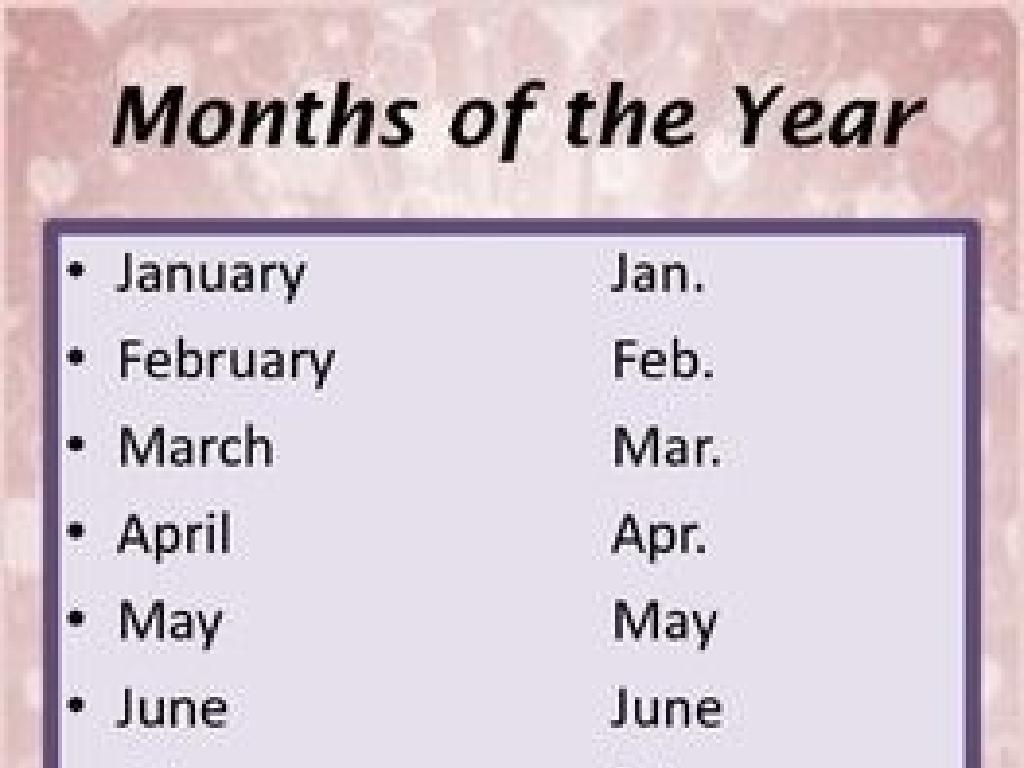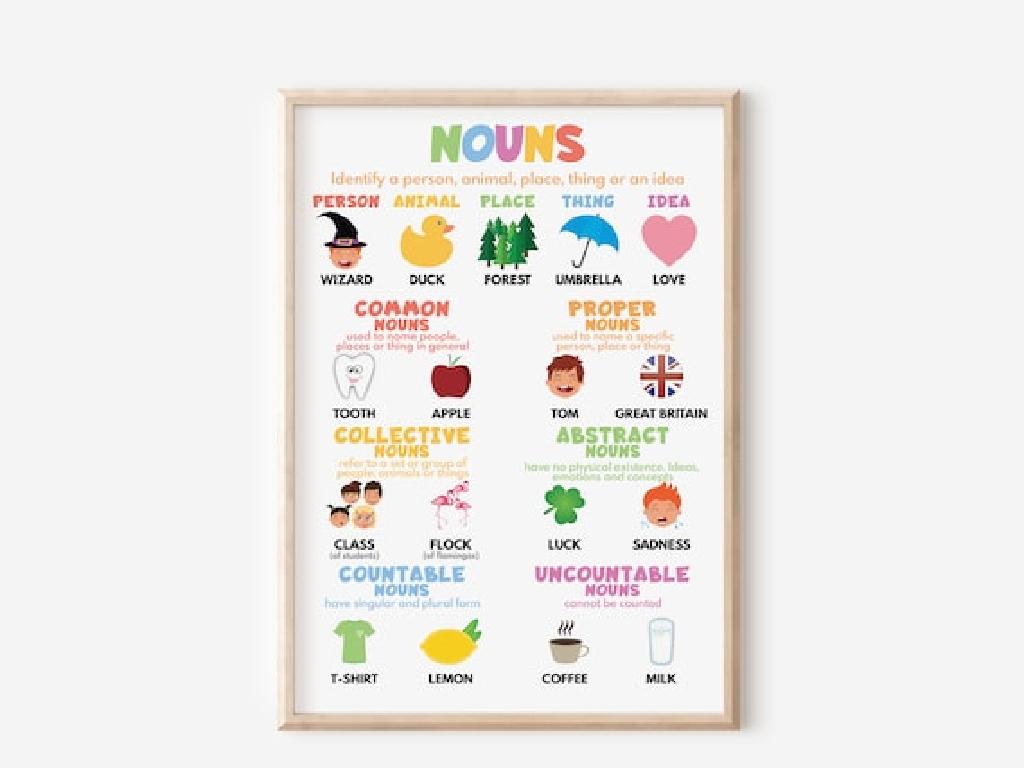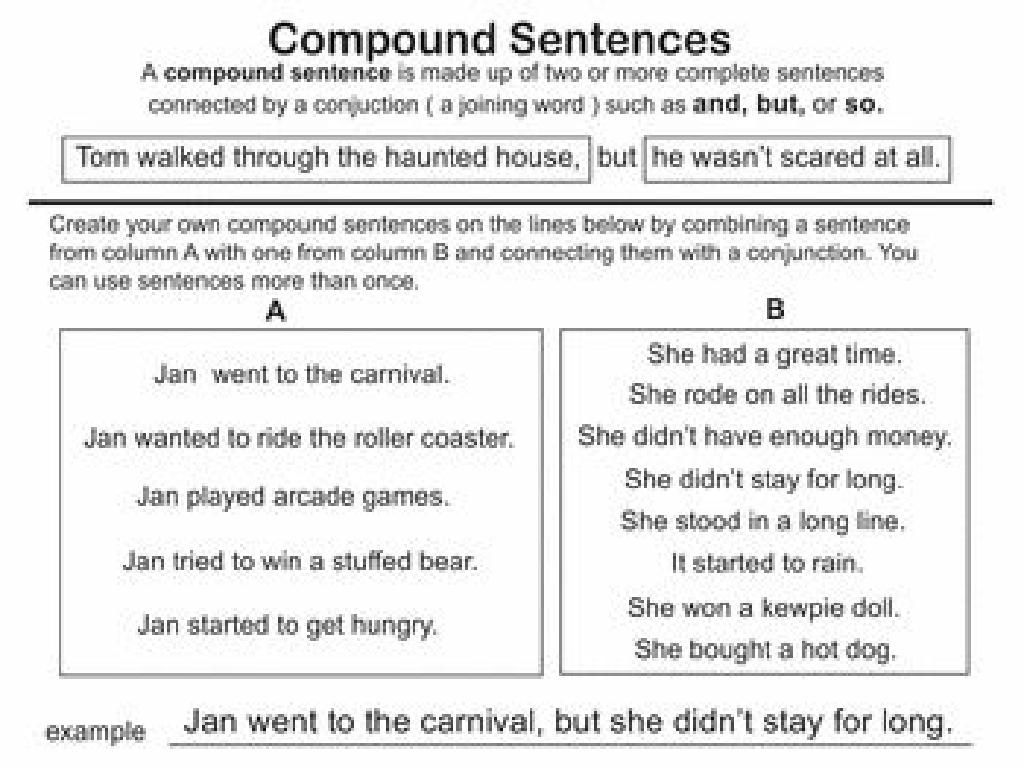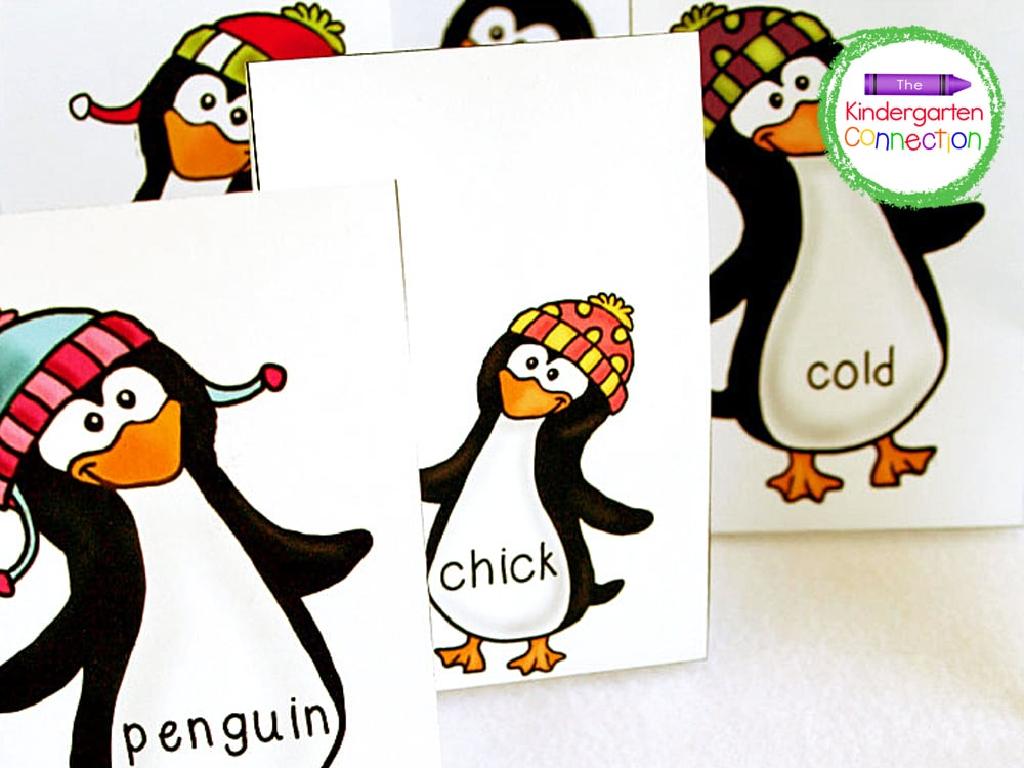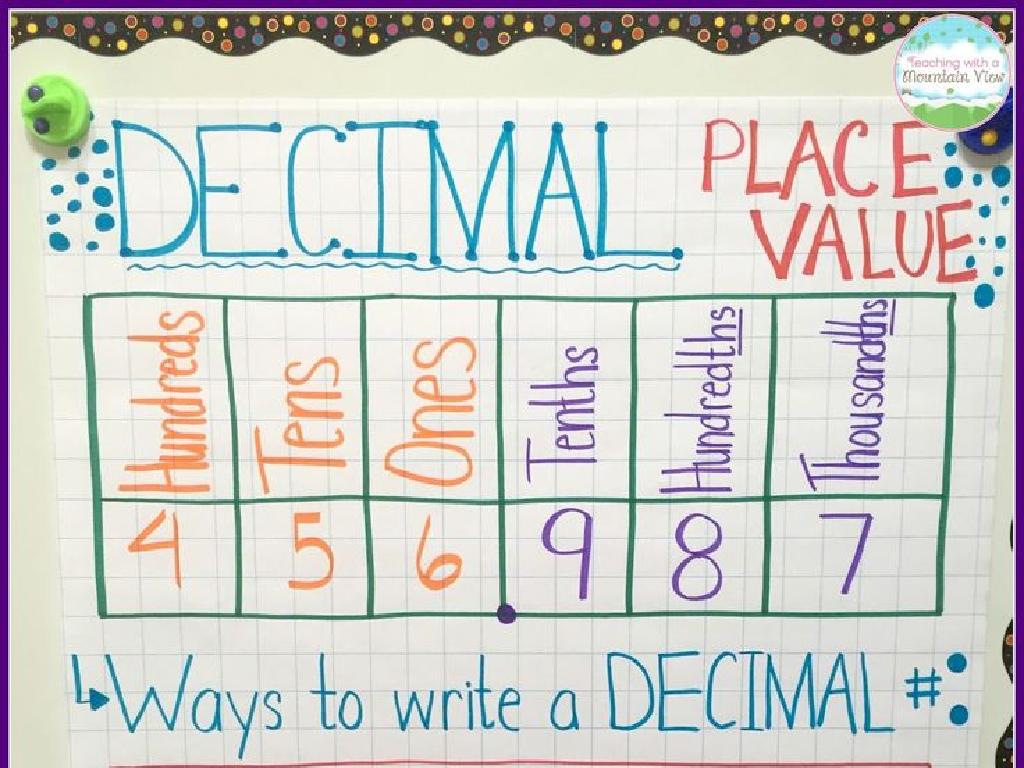One-Tenth Or One-Hundredth More Or Less
Subject: Math
Grade: Fourth grade
Topic: Add And Subtract Decimals
Please LOG IN to download the presentation. Access is available to registered users only.
View More Content
Welcome to Decimals!
– Recap: What are decimals?
– Decimals represent parts of a whole, like pieces of a pie.
– Explore tenths and hundredths
– Tenths are 1/10, hundredths are 1/100 of a whole.
– The importance of decimals
– Decimals are used in money, measurements, and more.
– Adding and subtracting decimals
– Learn to adjust amounts by tenths or hundredths.
|
Begin with a brief review of what decimals are and how they represent fractions of a whole, ensuring students recall prior lessons. Introduce tenths and hundredths by using visual aids like a pie cut into 10 or 100 pieces. Explain the significance of decimals in everyday life, such as in currency and measurements, to help students understand their practical applications. Teach students how to add or subtract one-tenth or one-hundredth by moving the decimal point to the right for tenths or to the left for hundredths. Provide examples and practice problems to solidify their understanding.
Visualizing Tenths
– Understanding a tenth
– One whole divided into 10 equal parts
– Pie chart: visual tenths
– Each slice of the pie chart represents one tenth
– Relating tenths to dimes
– 10 dimes make a dollar, just like 10 tenths make a whole
– Real-world examples
– Think of dividing a pizza or a dollar into 10 equal parts
|
This slide aims to help students visualize the concept of tenths as part of a whole. By dividing a pie chart into ten equal parts, students can see how each part represents one tenth. Relating this to money, such as dimes, provides a tangible example since ten dimes make a dollar. Encourage students to think of other real-world items that can be divided into tenths to solidify their understanding. Ask them to draw their own pie charts and label the tenths or to bring in examples from home that illustrate the concept of tenths.
Visualizing Hundredths
– Understanding hundredths
– Each part of a whole divided into 100 equal parts is a hundredth.
– 10×10 grid representation
– Visualize with a grid: each square is one hundredth of the whole.
– Hundredths and pennies analogy
– Just like 100 pennies make a dollar, 100 hundredths make a whole.
– Practice with real examples
– Use items like pennies to count and understand hundredths.
|
This slide is aimed at helping students visualize the concept of hundredths as part of a whole. By dividing a whole into 100 equal parts, each part is referred to as a hundredth. Use a 10×10 grid as a visual aid where each square represents one hundredth, which can help students grasp the idea that 100 of these make up a complete unit. Relate the concept to something familiar, like pennies in a dollar, where each penny represents one hundredth of a dollar. Encourage students to practice with real-life examples, such as counting pennies, to reinforce the concept. This will build a strong foundation for understanding decimals and their relation to whole numbers.
Adding Decimals: Tenths
– Adding tenths using a number line
– A number line helps us see the distance between numbers.
– Example: 0.3 + 0.7
– Starting at 0.7, move 3 tenths to the right to reach 1.0.
– Visual aids for practice problems
– Use images or blocks to represent tenths for better understanding.
|
This slide introduces students to the concept of adding decimal tenths using a number line, which is a visual tool that helps them understand the distance between numbers. By using the example of adding 0.3 to 0.7, students can visually see that moving three tenths to the right from 0.7 on the number line will result in 1.0. For practice, provide visual aids such as images or blocks to represent tenths, which will help solidify their understanding of the concept. Encourage students to solve additional problems using the number line and to explain their thought process as they add tenths together.
Subtracting Decimals: Tenths
– Subtract tenths on a number line
– Imagine hopping back on the number line to subtract
– Example: 0.9 – 0.4
– Start at 0.9, hop back 0.4 to land on 0.5
– Visual aids for practice problem
– Use images or blocks to show subtraction
|
This slide is focused on teaching students how to subtract tenths using a number line, which is a visual method that helps them understand the concept of subtraction with decimals. Start by explaining the number line and how each hop represents a tenth. For the example, show 0.9 on the number line and demonstrate how to move back four hops to subtract 0.4, landing on 0.5. Provide visual aids like images or blocks to represent the tenths, making it easier for students to grasp. Encourage students to solve the practice problem using the same method and provide additional problems for them to try on their own. This hands-on activity will reinforce their understanding of decimal subtraction.
Adding Decimals: Understanding Hundredths
– Use a number line for addition
– A number line helps us see the addition step by step.
– Example: 0.25 + 0.50
– Starting at 0.50, move 25 steps to the right to land on 0.75.
– Visual aids for practice
– Use pictures or blocks to represent 0.25 and 0.50.
– Try adding hundredths yourself
|
This slide introduces students to the concept of adding decimals, specifically focusing on hundredths. Begin by explaining the use of a number line as a visual tool to simplify the process of adding decimals. Show the example of adding 0.25 to 0.50 by marking these points on the number line and demonstrating how to ‘jump’ from one value to the other to find the sum. Provide visual aids such as blocks or pictures to represent the decimals in the example, making it easier for students to grasp the concept. Finally, encourage students to practice with similar problems, using the number line and visual aids to support their learning. This hands-on approach will help solidify their understanding of adding hundredths.
Subtracting Decimals: Hundredths
– Subtract hundredths on a number line
– Example: 0.75 – 0.12
– Start at 0.75, move back 0.12 to land on 0.63
– Visual aids for subtraction
– Use images or blocks to show subtraction
– Practice problem
– Solve: What is 0.75 minus 0.12?
|
This slide is aimed at teaching students how to subtract hundredths using a number line, which provides a visual representation of the subtraction process. Begin by explaining the concept of hundredths and how each point on the number line represents one hundredth. Use the example of subtracting 0.12 from 0.75 to show how to count back on the number line. Provide visual aids such as images or blocks to further illustrate the concept of taking away a smaller decimal from a larger one. Conclude with a practice problem, asking students to apply what they’ve learned by solving 0.75 minus 0.12. Encourage students to visualize the problem using the number line method and check their work with visual aids.
Understanding Decimals: One-tenth More or Less
– What does one-tenth more mean?
– It’s like adding a single penny to a pile of dimes.
– Example: 0.5 is one-tenth more than 0.4
– If you have 40 cents and find a dime, you now have 50 cents.
– Interactive class example
– Practice finding one-tenth less
– If you have 50 cents and give a dime away, you’re left with 40 cents.
|
This slide introduces the concept of one-tenth more or less in the context of decimals. Start by explaining that one-tenth refers to a single part of something divided into ten equal parts. Use money as an example, comparing dimes to one-tenth of a dollar. For the interactive example, involve students by asking them to add or subtract one-tenth from given numbers and share their answers. Finally, ensure students understand that finding one-tenth less is just the reverse of adding one-tenth. Provide several practice problems for students to solve, reinforcing the concept with real-world examples like money or measurements.
Understanding One-hundredth More or Less
– What does one-hundredth less mean?
– One-hundredth less is like taking away 1 penny from 34 pennies.
– Example: 0.33 is less than 0.34
– If you have 34 pennies and give 1 away, you have 33 pennies, or $0.33.
– Interactive class example
– Let’s use items in the classroom to show one-hundredth differences.
– Practice finding one-hundredth differences
– Find one-hundredth more or less than numbers I give you.
|
This slide introduces the concept of one-hundredth more or less, which is a foundational skill in understanding decimals. Start by explaining that one-hundredth is like a single penny in a dollar. Use the example of 0.33 and 0.34 to show how a difference of one-hundredth looks. Then, involve students in an interactive activity where they can use classroom objects to represent the concept physically. Finally, encourage them to practice with different numbers to solidify their understanding. For the interactive example, consider using manipulatives like base-ten blocks or coins to visually represent the concept. The teacher should prepare a list of numbers for the practice activity, ensuring a mix of numbers that are one-hundredth more or less than each other.
Class Activity: Decimal Scavenger Hunt
– Find decimal-priced classroom items
– Calculate one-tenth more or less
– If an item is $1.50, one-tenth more is $1.65, one-tenth less is $1.35
– Share and explain your findings
– Discuss how you figured out the new prices
– Understand decimal adjustments
– Grasp how small changes affect the total
|
This interactive activity is designed to help students apply their knowledge of decimals in a fun and engaging way. Students will search the classroom for items with prices that include decimals. They will then use their math skills to calculate one-tenth more or one-tenth less of each item’s price. This exercise will reinforce their understanding of decimal places and the concept of tenths. After calculations, students will present their findings to the class, explaining the process they used to arrive at the new prices. This will also enhance their communication skills. For the teacher: Prepare a list of possible items with decimal prices beforehand and ensure that each student or group has a different item to prevent repetition. Encourage students to use mental math or paper and pencil for calculations. Provide guidance as needed and facilitate the sharing session to ensure a supportive learning environment.

